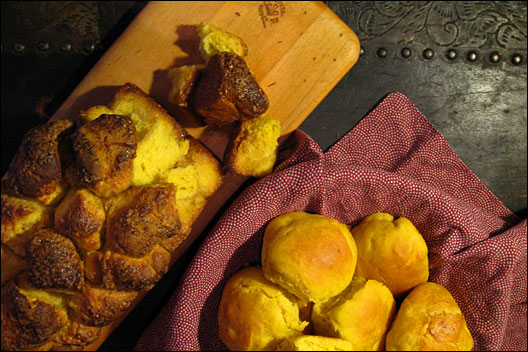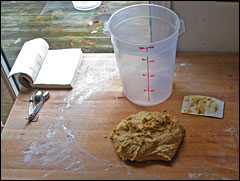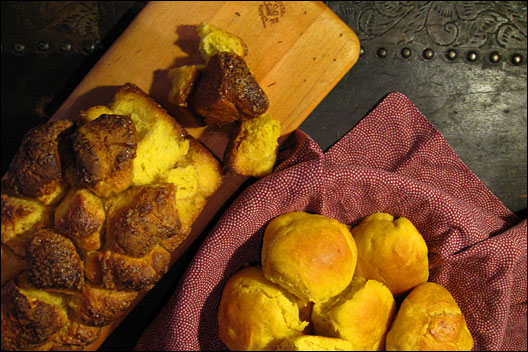 Sweet potato rolls.Photos: April McGregerI remember the look on my grandfather’s face when I tried to politely explain that I couldn’t eat the giblet gravy or the dressing (known in other parts of the country as “stuffing”) that I had always relished. The reason, I informed him, was that I was a vegetarian; those old favorites contained turkey broth.
Sweet potato rolls.Photos: April McGregerI remember the look on my grandfather’s face when I tried to politely explain that I couldn’t eat the giblet gravy or the dressing (known in other parts of the country as “stuffing”) that I had always relished. The reason, I informed him, was that I was a vegetarian; those old favorites contained turkey broth.
He replied with a blank stare. It was a completely isolating experience. In a family where preparing and sharing food is our strongest form of emotional currency, my rejection of my family’s food was a rejection of their affection and a rejection of my culture.
Before I had become a vegetarian, I had been “called” to carry on my grandmother’s cornbread dressing and giblet-gravy tradition. I had stood at her elbow to learn the craft of one of my family’s most prized foods. Now my personal diet choices threatened the survival of a family heirloom.
Tradition and Its Discontents
That was years ago. But as I listened to an interview with Jessica Prentice, author of Full Moon Feast: Food and the Hunger for Connection, these memories resurfaced. In the interview, radio host Caroline Casey and Prentice suggest adopting flexible working food principles along these lines: “Whatever increases our sense of kinship is sacrament and nutritious food. Whatever increases our sense of alienation is poison.”
Somewhere in the last five years, progressive food culture has begun to evolve beyond the minefield of infinite individual food rules to valuing conviviality, inclusion, and a more tolerant mindset. This progress can be attributed to a wide variety of sources. Sally Fallon’s Nourishing Traditions taught us to relax fat-phobic diet rules and to value traditional food knowledge. The wide popularity of Michael Pollan’s Omnivore’s Dilemma brought to light the dilemmas of the industrial diet — including vegetarian ones.
When we begin to reconnect to land and place and attempt to eat a diet of locally grown whole foods, we have to reconsider our reliance on industrially produced soy burgers with lengthy ingredient lists full of words we can’t pronounce. Maybe we see our own family food traditions unraveling, and we contemplate the hand that our purity-seeking food choices have played in that process. We learn that we have to choose to be part of a community, and that doing so requires that conviviality take precedence over our rigid personal diet rules.
I do not mean to say that we should just quietly accept the factory-farmed turkey that is handed to us as inevitable. I hope only to encourage the preservation of hospitableness. This is new territory for most of us, and I am interested in hearing your stories. How do you reconcile your personal food choices and your family traditions? What are creative means for doing this?
The Bitter with the Sweet
Regardless of the menu, many have conflicted feelings about celebrating Thanksgiving at all, and rightly so. In the interview, Prentice remarks that Thanksgiving represents the very best and the very worst of our country. On one hand Thanksgiving is a celebration of the colonial wiping out of indigenous people, but it is also an exceptional day of national gratitude and a relatively noncommercial, inclusive celebration of nature.
Shunning Thanksgiving will not undo the harm that Europeans wrought on Native Americans. We can, however, look to Thanksgiving celebrations as an opportunity to show ceremonial reverence to the wisdom of indigenous and traditional cultures and to reclaim the connections — to our community, our cultures, and our food sources — that we as a nation have largely lost. This brings to mind the words of Native American activist Winona LaDuke. In a speech at Terre Madre in Turin, Italy, this year, she said Native Americans regard all creatures and all plants as their relatives; and if we care for these living things as such, they will care for us in return.
We can do this by valuing the story of our foods. Where did they come from? Who nurtured them year after year, saved their seeds, and passed them to the next generation? Who grows them for us now? How did these foods become cherished? What is the source of our traditions?
Sweet Potato Everlasting Rolls
I take great pride in the fact that I have reintroduced my family to an old Southern recipe for potato yeast rolls that has broken their addiction to the hydrogenated-oil-laden, pre-made variety. And I did it by making an argument based on practicality, not judgment. As working women, my mother and grandmother never wanted to fool with yeasted bread, and certainly not in addition to an already labor-intensive holiday meal.

Easy-to-make rolls: one more thing to be thankful for.
However, this recipe gets its name from the fact that it lasts and lasts. You can make the rolls as early as a week ahead and keep the dough in the refrigerator until needed. That convenience won my family over. The traditional recipe is made with a white-potato starter, but I employ the sweet potato. It is significant to my hometown of Vardaman, Mississippi, which holds a Sweet Potato Festival every year complete with a queen and cooking contests. The sweet potato also offers its beautiful autumnal color and natural sweetness to the dough. Feel free to substitute white potato, or even pumpkin, in its place. I love to make a double or even triple batch of these rolls, bake them off in disposable pie tins, and take them around to friends and extended family on Thanksgiving morning. Nothing is more appreciated than homemade yeast rolls.
3 tablespoons lard (or safflower or sunflower oil)
3 tablespoons butter
1 cup buttermilk or milk
1/2 cup honey or 1/4 cup sugar
1 cup mashed baked sweet potato
1 1/2 cups Sweet Potato Starter, recipe follows
2 eggs, beaten
6 1/2 cups all-purpose flour
2 teaspoons salt
1/2 teaspoon baking soda
1 teaspoon baking powder
Melted butter
Bring the lard, butter, buttermilk, and honey (or sugar) to a low boil while stirring. Remove from heat and stir in the mashed sweet potato. When cooled to lukewarm, stir in the sweet potato starter. Beat in the eggs. Beat in the flour, one cup at a time. Beat in the salt, soda, and baking powder, then turn out onto a floured surface and knead for 10 minutes, adding as little flour as possible to the dough.
Transfer the dough to a lightly oiled bowl or container at least twice its size and cover tightly. Let the dough rise in the refrigerator at least 6 hours and up to one week tightly covered.
To bake rolls, butter an 8- or 9-inch pie pan. Preheat oven to 400 degrees F.
With buttered hands, pinch off walnut-sized pieces of dough and roll into 2-inch diameter balls. Place 7-8 in each pie pan. Cover with a damp towel and sit aside to rise until double in bulk, about one hour. Brush the tops of the rolls with melted butter and bake for 10 minutes until golden brown. Serve warm with homemade honey butter. (Whip honey into soft, lightly salted butter.)
Sweet Potato Starter
4 cups water
1/4 cup all purpose flour
2 tablespoons honey
2 teaspoons kosher salt
1 package dry yeast or 2 1/4 teaspoons of instant yeast
Cook the sweet potatoes in the water in a saucepan until tender. Drain the potatoes and reserve the water. Press the sweet potatoes through a fine strainer or food mill. Add the reserved water, whisk to combine, and let cool to lukewarm. Mix in the remaining ingredients and sit aside at room temperature for 6-8 hours or until frothy. It is now ready to use. Refrigerated it will keep about 2 weeks.
Sweet Potato-Cardamom Monkey Bread
Another reason to make a big batch of the sweet potato yeast roll dough is that the dough can be manipulated to endless variation, and it solves the question of what you can serve for breakfast on Thanksgiving morning. Use as a base for cinnamon rolls or fold in dried cherries or cranberries and pecans to the dough. This recipe is my variation on a favorite Southern breakfast or tea bread with a funny name. The bread is also called “pull-apart bread” because it is never sliced, but simply pulled apart in segments. The flavor of this bread is similar to a cinnamon roll. You can use cinnamon as the spice called for here; add nuts, raisins, or whatever your favorite ingredients are. A Bundt pan serves 12 and uses entire recipe of dough; 1 pound loaf serves 6 and uses half recipe.
Butter pan. Preheat the oven to 350 degrees F.
Melt 4 tablespoons butter in a small bowl. Combine 1/2 cup of turbinado sugar with 1/2 teaspoon of ground cardamom in another bowl. Pinch off walnut-sized pieces of the dough, dip them in butter, roll them in sugar (or sprinkle them with sugar if you prefer them less sweet), and layer them in pan. Cover the dough with a damp towel and let rise for two hours.
Bake until the loaf is firm and golden brown, about 45 minutes. Let cool slightly and remove from pan. Serve hot or at room temperature. Remember to tear the bread instead of slicing it.


